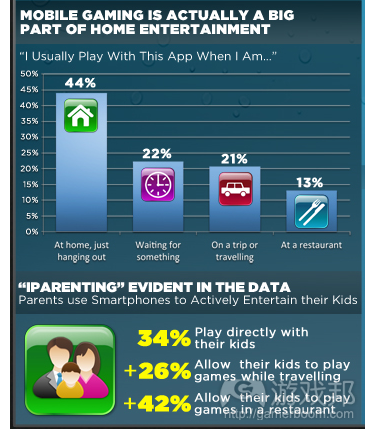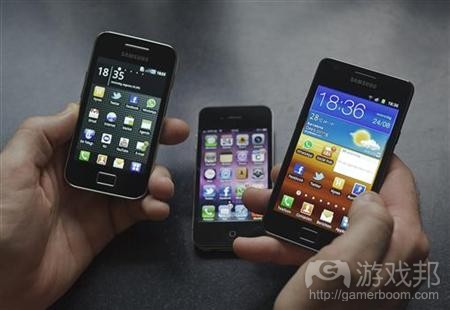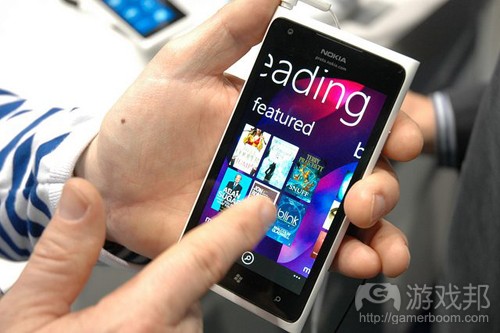每日观察:关注用户投诉苹果新iPad运行热度过高(3.21)
1)休闲游戏公司Miniclip与移动广告服务供应商MoPub最近调查报告指出,手机游戏玩家更经常在家玩游戏,这一用户比例达到44%(游戏邦注:该报告调查样本为1625名Miniclip手机游戏用户)。
多数iOS和Android玩家坐在沙发上玩手机游戏,22%受访者在等待过程中玩手机游戏。有34%家长使用智能手机和平板电脑与孩子玩游戏。
42%家长在餐馆中让孩子玩手机游戏;益智游戏是最受欢迎,多数18-54岁受访者喜欢益智游戏胜过动作类或体育类游戏。
2)Juniper Research最新报告预测,平板电脑游戏收益将从2011年的4.91亿美元,增长至2014年的31亿美元;预计到2016年整个移动游戏市场营收将达183亿美元。
报告将原因归结为平板电脑提供了最适合玩游戏的屏幕,针对该设备设计的游戏一般也拥有更出色的图像效果和用户体验。这些因素将促使用户购买更多游戏,进行更多IAP消费。此外平板电脑用户经济条件也优于智能手机用户,所以为游戏消费的愿意更高。
报告还指出,功能性手机游戏市场份额将明显缩水,其收益在今后5年将减少一半。
3)跨平台开发技术供应商Appcelerator与IDC最近针对全球2173名开发者的调查报告表明,尽管多数开发者的选择仍是原生应用,但纯手机网页应用及“混合”应用(同时采用本地代码和HTML5技术)的人气也明显上升,有78%开发者将在2012年采用HTML5技术。
除此之外,开发者对云服务也表现出了极大兴趣,超过58%的开发者已在使用该服务或者考虑将其植入自己的产品中。地理定位和信息推送通知则是开发者最常提到的两大服务。
有53.5%的受访者表示将提升自己在移动领域的发展策略,2010年的这一比例则是27.4%。
从目标平台上看,iOS最受青睐。89%的受访者对iPhone很感兴趣,而iPad的开发者支持率也达到了88%。
Android手机的开发者支持率为78.6%(下降了4.7个百分点),Android平板电脑支持率为65.9%(下降2.2个百分点)。Windows Phone 7仍是排名第三的操作系统,其支持率为17%。而黑莓操作系统的开发者支持率则
从2011年第四季度的20.7%下滑至今年第一季度的15.5%。
其他调查发现包括:
*开发者难以找到让手机应用中的社交资产(包括Facebook的社交图谱)发挥作用的方法,他们更愿意绑定谷歌搜索引擎、YouTube、Gmail、谷歌地图等功能。
*39%受访者称谷歌资产的网络效应对自己2012年的社交策略更重要,其作用超过Facebook的社交图谱。
4)据路透社报道,近日有一些苹果新iPad用户在苹果论坛上发贴指出,新iPad设备在运行过程中(尤其是玩3D游戏时)很容易发热,其上升温度甚至到了令人难以接受的程度。
荷兰网站Tweakers发布的一张热成象摄像图片显示,新iPad的运行温度确实超过了前两代iPad设备。iPad 2(使用A5双核芯片)运行时的温度为28.3摄氏度,而新iPad(采用A5X芯片,包含四核GPU)运行温度高达33.6摄氏度。
不过该网站也指出,尽管新iPad升温过于明显,但还没有像投诉用户所称的“热得无法拿住iPad”那样严重。对此苹果发言人仅回应称,新iPad的运行符合“苹果的热度标准”。
5)据Techcrunch报道,移动视频服务供应商Vuclip最近调查结果发现,33%男性用户是看价格挑选手机,看功能买手机的比例则是31%。与此同时,有37%女性用户是根据功能来挑选手机,有20%是以屏幕大小为主要参照标准,仅有18%是看价格买手机(游戏邦注:该调查共有56万回复受访者)。
37%受访者打算升级到Lumia等诺基亚设备,有25%打算升级到iPhone,90%的iPhone用户则表示仍将支持苹果产品。
6)Chetan Sharma Consulting最近报告预测,2012年美国移动数据收益将从2011年的670亿美元增长至800亿美元,移动数据目前已占全美手机网络流量的85%,约有三分之一的用户每月消费1GB的数据流量。
美国市场的无线网络用户仅占全球的5%,但却产生了全球17%的网络服务收益,以及21%的全球移动数据,全球40%的智能手机销量。
与此同时,有90%的平板电脑用户仅使用Wi-Fi网络,尽管有些平板电脑也支持使用移动网络。预计平板电脑用户今后将占据更多移动网络带宽。
威瑞森是美国排名第一的LTE网络供应商,居于其次的是AT&T。
7)Kantar Worldpanel ComTech最新报告表明,诺基亚Lumia 800手机在英国销量占所有WP7设备销量的87%,WP7在英国市场份额达2.5%,而Symbian市场份额则从一年前的12.4%下滑至2.4%。
苹果iOS在英国智能手机市场份额从一年前的22.7%增长至2012年的28.7%。Android仍是英国头号智能手机操作系统,所占份额达48.5%。
苹果的用户满意度最高,达到8.8分,三星以8.0分位列其次,HTC以7.6分位居第三。
报告还显示,用户现在会使用更多移动设备上的功能。例如,过去四周中有近半数用户使用手机上的GPS或地图功能,而一年前的这一比例仅有33.9%。有39.2%用户会通过手机下载或观看视频内容,而去年的这一比例仅为10.6%。(本文为游戏邦/gamerboom.com编译,拒绝任何不保留版权的转载,如需转载请联系:游戏邦)
1)Study: Mobile gamers play on the couch more than anywhere else
by Joe Osborne
Finally, we can all admit to being total couch potatoes. A study conducted by casual games company Miniclip and mobile ad server MoPub found that mobile gamers play more while at home than anywhere else–44 percent, to be exact. (Recent NPD data would agree.) The results are thanks to 1,625 mobile Miniclip gamers that answered a voluntary questionnaire.
And said results give us a good idea of both where players like to get their the game on and with that kids of games. While the majority of iOS and Android gamers play while working on their couch groove, a healthy 22 percent play while waiting for something out in the world. Fortunately, a considerable amount of that time spent on the couch could be some good old bonding. According to the study, 34 percent of parents use smartphones and tablets to play games with their kids.
However, a not-so-surprising number of parents seem to use smartphones as what I like to call shut-the-hell-up slabs: 42 percent of parents let their kids play mobile games while in a restaurant. As for what games are most played on mobile, puzzlers seem to have won that popularity contest, at least among older gamers. The majority of mobile game players aged 18 to 54 prefer puzzle games over action and sports games. Check out the infographic below for more neat-o findings.(source:games)
2)Tablet gaming market will be worth $3.1 billion in 2014 reckons Juniper Research
by James Nouch
Juniper Research has issued a report which forecasts substantial growth in gaming revenues from tablets – from $491 million in 2011 to $3.1 billion by 2014.
The report argues tablets offer the optimum screen size for gaming, and that games designed for tablets typically enjoy superior graphics and user interfaces.
These factors encourage users to buy more games and make more in-app purchases, according the report’s author Charlotte Miller. Indeed, the games are often more expensive too.
Miller also reasons that the relative expense of tablets suggests that tablet owners have more disposable income than smartphone owners, and are therefore more likely to purchase games.
Deep pockets
It’s these factors that lead Miller to state that tablets will account for nearly a third of overall mobile games revenue by 2016.
The report predicts a less rosy future for gaming on feature phones, though. Mobile games revenue from these devices will halve over the next five years, apparently.
“The tablet is the perfect device for playing mobile games – the screens are large enough for the user to see the action, no matter how big their hands are,” Miller explained.
“Tablet owners also tend to have a larger disposable income, as tablets are often bought outright rather than subsidised by operators.
“Higher user satisfaction with games and a bigger wallet mean that tablet games look to be highly lucrative.”(source:pocketgamer)
3)78 per cent of developers will integrate HTML5 in 2012
by Tim Green
Broad market survey reveals rising interest in web and hybrid apps.
The cross-platform development specialist Appcelerator teamed with IDC in a survey of 2,173 developers around the world.
It revealed a coding space still dominated by native apps, but one which is showing a strong interest in pure mobile browser apps and ‘hybrids’ that integrate both native code and substantial amounts of HTML5.
Linked to this, the study also reported that interest in cloud services has soared with over 58 per cent of developers either using or considering using them in their mobile apps. Location and notifications are the top two services cited.
Overall, mobile app development continues to grow, with 53.5 per cent of respondents accelerating their mobile strategies compared to 27.4 per cent in 2010.
The way Appcelerator describes it, most respondents are in the ‘acceleration phase’ now (as opposed to the innovation phase), with the expectation that they will be building multiple applications on a number of different operating systems.
In terms of platforms, iOS is the clear leader. 89 per cent of respondents say they are very interested in developing for the iPhone, with the iPad at 88 per cent.
Interest in Android phones dropped 4.7 per cent to 78.6 per cent, while Android tablets dropped 2.2 per cent to 65.9 per cent. Fragmentation isn’t helping.
Windows Phone 7 remains the number three OS in terms of priorities at 17 per cent. Which won’t be great news for RIM, whose BlackBerry OS saw developer interest decline from 20.7 per cent
in Q4 2011 to 15.5 per cent in Q1 2012.
Other key findings include:
* Developers are struggling to understand how to leverage social assets in their mobile apps, including Facebook’s social graph. Indeed, they are more interesting in the combined network effects of Google’s various properties – Google search, YouTube, Gmail, Google Maps, etc.
* 39 per cent of developers say that the network effects of Google’s broad range of assets are more important to their social strategies in 2012 than Facebook’s social graph.(source:mobile-ent)
4)New iPad investigated for claims of overheating
by Keith Andrew
Owners of Apple’s new iPad have taken to the web to claim the tablet is overheating, with temperatures rising to what some have claimed is an unacceptable level.
Comments posted on Apple’s forum point to the device running especially hot when playing 3D games, with the bottom left side of the iPad’s screen apparently the area worst effected.
Others, however, have suggested the whole device heats up, making it uncomfortable to hold.
Hot gossip
As a result of such complaints, Reuters states electronics review specialist Consumer Reports is to publish findings on claims iPad emits excessive heat when in use based on a “battery of tests” designed to simulate actual usage.
The firm has, however, been beaten to it to some extent, with Dutch website Tweakers – translated by the Daily Mail – claiming a photo taken with a thermal imaging camera illustrates that the latest iPad does indeed run at a higher temperature than its predecessor.
New iPad on the left, iPad 2 on the right
The site claims iPad 2 (using the dual-core A5 chip) runs at a temperature of 28.3° Celsius, while Apple’s latest update (with the A5X chip, including a quad-core GPU) runs at 33.6° Celsius – proof that those who have complained aren’t imagining the jump in temperature, the site claims.
Nonetheless, Tweakers does state that, while the new iPad’s “warming housing is noticable”, it isn’t – as some have claimed – “too hot to touch.”
Apple itself has offered little in response, with a spokesperson for the company telling Reuters that the new iPad operates “within our thermal specifications.”(source:pocketgamer)
5)When It Comes To Phones, Men Are More Price-Sensitive (According to Vuclip)
Anthony Ha
For its latest user survey, mobile video service Vuclip decided to look at why people buy the phones they do — specifically, at the differences between men and women.
And indeed, there was a real contrast between male and female respondents. When men were asked about the most important factor when choosing a phone, the most popular answer (chosen by 33 percent) was price, followed closely by features (31 percent). When women were asked the same question, the most popular answer was features (37 percent), followed by screen size (21 percent). Only 18 percent of women said that price was their biggest concern.
Beyond the Men Are From Mars, Women Are From Venus angle, the survey also asked people when they expect to buy their next device, and 32 percent said they have no plans to replace their phone in the next month. The survey also asked what brand they expect their next device to be, and the most popular response was Nokia (!), at 37 percent. Apple came in second with 25 percent, and it also had impressive brand loyalty — of people who currently own an iPhone, 90 percent said they would stick with it for their next purchase.
The survey will be posted on the Vuclip site Tuesday morning. (I’ll update this post with a link when it is.) It was conducted over the month of February — respondents had to watch at least three videos, but other than that, the company says they were randomly selected. The survey received 560,000 responses total.(source:techcrunch)
6)US mobile data to hit $80bn in revenue this year
by Zen Terrelonge
Chetan Sharma Consulting says mobile data revenues will continue to grow in America to hit $80 billion in 2012, rising from $67 billion in 2011 when it accounted for over one-third of total revenues.
Data itself now accounts for 85 per cent of mobile web traffic in the US, according to the report, with almost one-third using more than 1GB each month. Presumably driven by the consumer zest for streaming viral content on YouTube and so on
The US occupies five per cent of wireless subscribers, but generates 17 per cent of global service revenues and 21 per cent of global mobile data, while securing 40 per cent of global smartphone sales.
Meanwhile, 90 per cent of tablet owners use wi-fi only connections although some are capable of mobile connections. However, Sharma claims operators that offer data bundles for multiple devices will see tablet users begin to use mobile broadband.
Additionally, Verizon ranked as the number one LTE provider, followed by AT&T.(source:mobile-ent)
7)Windows Phone 7 outsells Symbian in UK
by Tim Green
2.5 per cent versus 2.4 per cent.
New data from Kantar Worldpanel ComTech will be met with a mixed response from Nokia.
One the one hand it seems its switch to WP7 at the high end is paying off. Indeed, its Lumia 800 phone took 87 per cent of all sales on the Microsoft OS in the UK.
But this is countered by the dramatic fall in Symbian which, let’s not forget, is still the platform of choice for its lower end handsets.
Symbian’s share was 12.4 per cent one year ago compared with 2.4 per cent now.
Elsewhere Kantar Worldpanel notes that WP7 has a 2.5 per cent share across Europe, and that Apple has increased its share of the British smartphone market from 22.7 per cent a year ago to 28.7 per cent in 2012.
However, Android remains the number one OS in the UK, at 48.5 per cent.
Apple has the most satisfied customers with a score of 8.8, with Samsung in second place at 8.0 and HTC in third with 7.6.
The research also found that people are using more features more often on their devices. For example, just under half of people in the past four weeks used GPS or maps compared to 33.9 per cent a year ago.
Similarly, 39.2 per cent are now downloading or streaming videos to their mobiles, from 10.6 per cent a year ago.(source:mobile-ent)













































 闽公网安备35020302001549号
闽公网安备35020302001549号